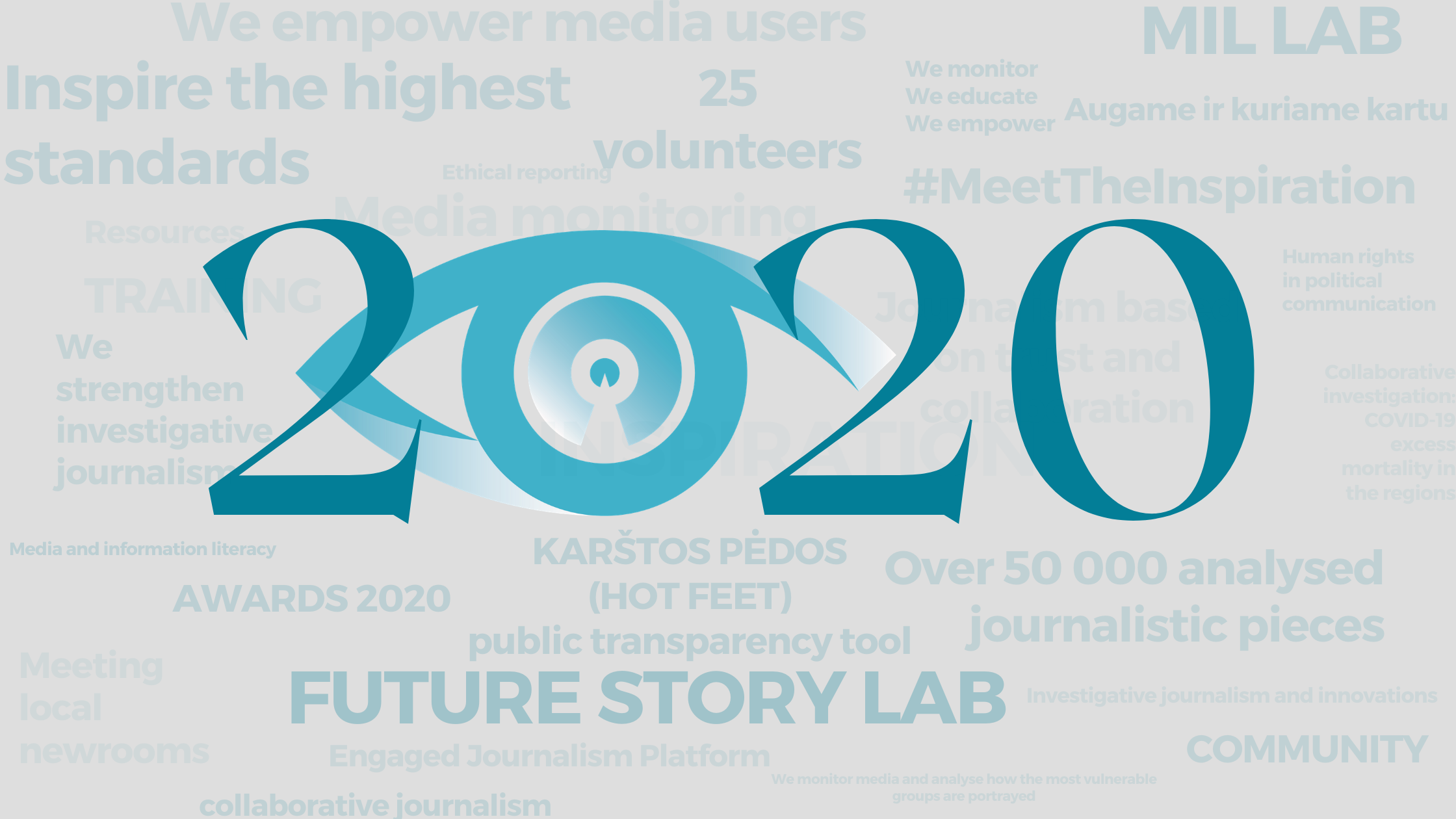The Media4change movement conducted media monitoring in 2020 to monitor journalistic work on mental health, sexual orientation, migration, religion and ethnic minorities. For the analysis, works were selected based on predefined keywords which discussed the above topics in the context of Lithuanian news.
MEDIA MONITORING: REVIEW OF 2020
The Media4change movement conducted media monitoring in 2020 to monitor journalistic work on mental health, sexual orientation, migration, religion and ethnic minorities. For the analysis, works were selected based on predefined keywords which discussed the above topics in the context of Lithuanian news.
Summary
In 2020, the Media4Change media monitoring team analyzed 50,951 journalistic works in the Lithuanian media. For the analysis, works were selected based on predefined keywords which discussed the above topics in the context of Lithuanian news. National and regional media, news agencies, magazines, television and radio news broadcasts were monitored in order to find how the media represents the most stigmatized groups in Lithuania.
Eight groups were being monitored – migrants, people with mental health disorders, the LGBT+ community, as well as religious (Muslim) and ethnic (Polish, Russian, Jewish and Roma) communities. The report focuses on three main areas: voice, topic distribution and context.
The data shows that the group with the most representation in the media is the Jewish ethnic minority (10757 journalistic works), and the least – the Roma ethnic minority (1567 works).
Regarding most of the researched groups, the media is mostly neutral, averaging ~ 74-87 percent in terms of neutral context. This is not the case regarding the Roma community, where the amount of neutral articles is 20 percent lower. The representation of Roma people in the media is the most negative out of all groups, with negative context reaching 34 percent. This number is almost twice as high as the second most negatively represented group in Lithuanian media – Muslims, who also have a high percentage of negative works (19 percent). The representation of these two groups differs from others in that there are many criminal publications emphasizing their religious or national identity.
The results of the study also show that a representative of the group was interviewed in less than 1/10 of publications that mentioned the groups. The voices of the LGBT community and the Roma ethnic community were comparatively heard the most. Though in the latter case, the media tended to speak to two people: singer Radži or the head of the Roma community and leader of the Sare Roma ensemble, Ištvan Kvik.
The portrayal of each of the groups was examined according to several criteria: the distribution of media type, genre, topic, context, speakers, main topic, as well as headline, stereotype analysis and comparison of sources. Among them, the main aspects that will be discussed in regards to each of the groups:
Voice
One of the most important aspects that media monitoring looks at is the activeness of the depicted group. The important thing to look at is whether a representative or member of a certain group is speaking for themselves or if the group is only being talked about. This shows whether the group is presented as a passive (“silent”) part of society or as active, participatory. By not giving the voice to a group, they are deprived of a platform, which is an opportunity for the group to form public opinion about its community by itself.
Topic distribution
Media monitoring also observes the thematic contexts in which the groups under study appear. This indicator helps identify which dominant discourses shape the image of a group in the media and what current issues affect the representation of groups.
Context
Another important aspect is the context in which the groups under study appear. It is divided into three types: positive, negative and neutral. Positive representation in the media can help break down stereotypes, while negative representation can encourage even greater hatred and demonization of the group. Although neutral journalistic works are found most often, the negative trends found in regards to several groups are concerning.
Positive portrayals of the most stigmatized groups can help combat stereotyping, generalization (not attributing one person’s actions to the whole community) and changing public opinion. It is because of the important role of the media in shaping our opinion that the abundance of negative representation can become a problem. If the number of publications with negative connotations represents a large percentage of all publications, it becomes crucial to pay attention and rethink the ways in which marginalized groups are portrayed.
You can read about the tendencies found in regards to each group down below.
Migration | Mental health | Sexual orientation | Muslims | Poles | Russians | Jews | Roma
Migration
In 2020, the topic of migration was found in 7 230 journalistic works in the Lithuanian media. Out of these, migration was chosen as the main topic in 2 393 (33.1%) works, which mostly revolve around the European Union’s migration policy and the integration policy in Lithuania. The amount of content on the latter has increased dramatically as the political situation in Belarus changed.
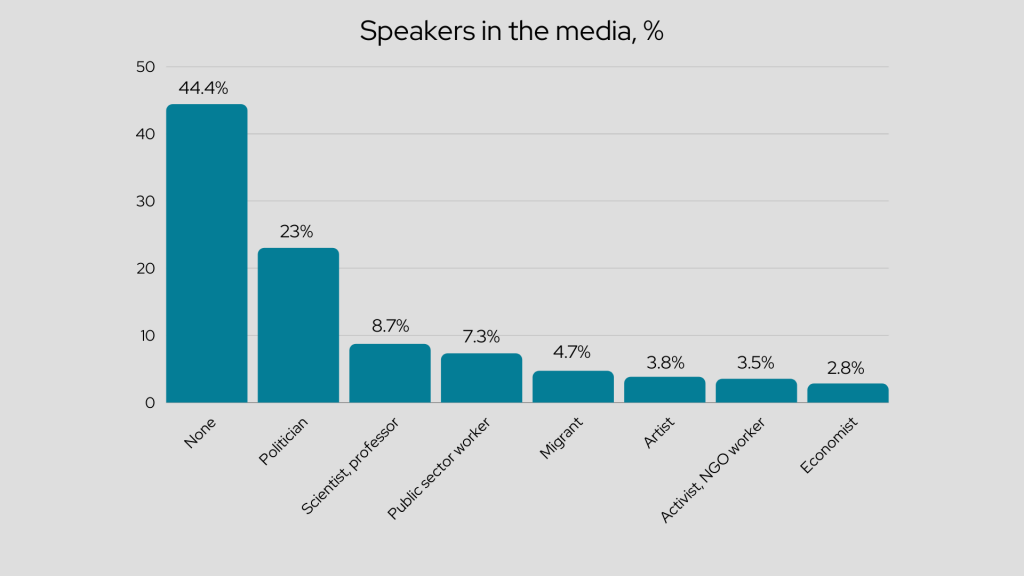
Politicians were most frequently cited in regards to migration, accounting for almost a quarter of all publications. In addition to politicians, other experts in the media, such as scientists, government officials, and economists were also cited, which largely illustrates the political and economic context in which migrants regularly appear. Meanwhile, such categories as artists and activists were closely linked to the fight against discrimination and initiatives that promote an empathetic attitude towards refugees and their integration.
Migrants were cited in 4.7 percent of all publications. If we were to break down this figure, 1.8 percent were refugees and asylum seekers, 1.4 percent Lithuanian migrants and the remaining 1.5 percent – other migrants. The works in which refugees in Lithuania were interviewed were mostly dedicated to their stories about integration and adaptation in the country. The most frequently interviewed were Syrians, Belarusians and Ethiopian Eskedar Maštavičienė, who acquired Lithuanian citizenship this year. In foreign context publications, refugees are quoted in terms of topical issues, such as military conflicts and refugee camps.
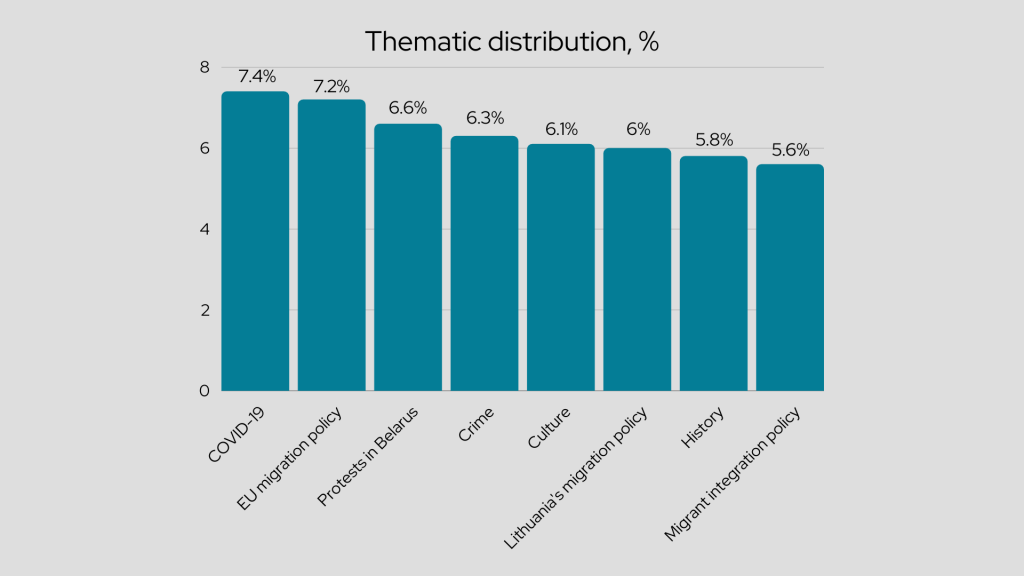
Looking at the thematic distribution, a single dominant theme cannot be distinguished. This is partly due to the fact that a lot of material on migration deals with specific events or situations in various parts of the world – military, political, ecological unrest and crises. Among such events this year, the COVID-19 pandemic, the political situation in Belarus, the US migration policy in the context of the presidential election, and the disasters in refugee camps received the most attention in the Lithuanian media.
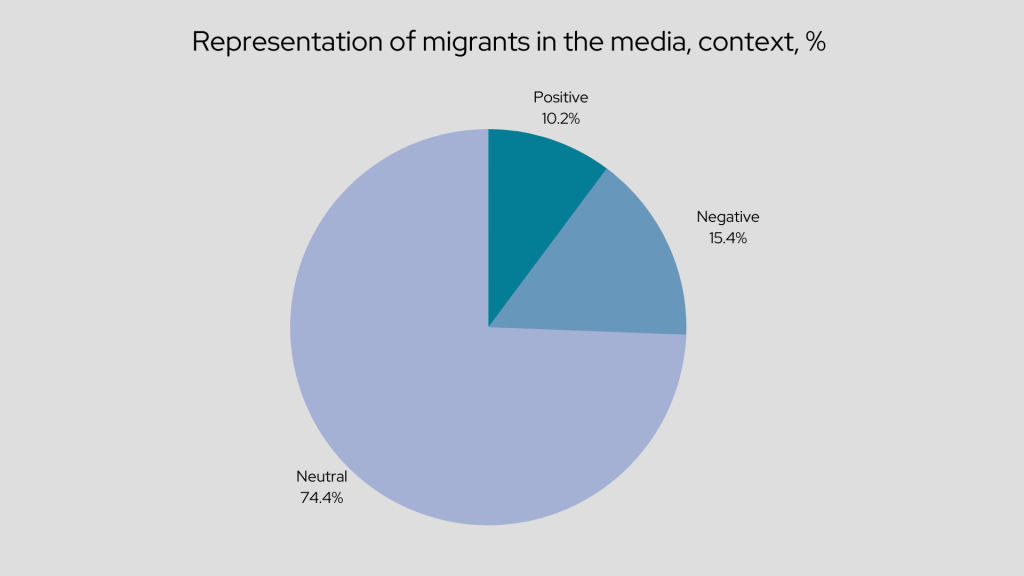
In the media, migrants are mostly represented in a neutral way, but the number of negative publications is higher compared to the number of positive publications. Negative content appears more often when reporting on foreign events rather than Lithuanian (two thirds of negative journalistic works talk about foreign news). Thematically, negative publications mainly include the arrival and ‘spread’ of migrants in Europe (12.5% of negative context), migrants and refugees in the COVID-19 pandemic (11.1%), and criminal publications (32.3%). The dominant narratives had a common denominator: regarding the migrant as the “Other”. This otherness justified the exclusion of the migrant from the rest of society, arguing that the migrant is destructive towards the established system, and brings a new evil with themselves (religious, racial and socio-economic dimensions are intertwined here). These narratives appeared not only in commentary style writings but also in news reports, the latter accounting for 48.2% of all negative content.
Meanwhile, positive representation appeared in cultural contexts (17.1% of positive context), often in events and social initiatives aimed at drawing attention to the issues migrants face. A positive way of speaking could also be seen in terms of Lithuania’s migration and integration policy (16.8%), including the issue of refugees from Belarus.
Mental health
In 2020, 5 785 journalistic pieces on mental health were examined. In 2 106 of them (36.4%), mental health was the main topic. Most of these publications discussed mental health disorders – their course, symptoms, causes (34.4% of works in which mental health is the main topic); to add to that, a significant amount was specifically dedicated to mental health during quarantine (29%).
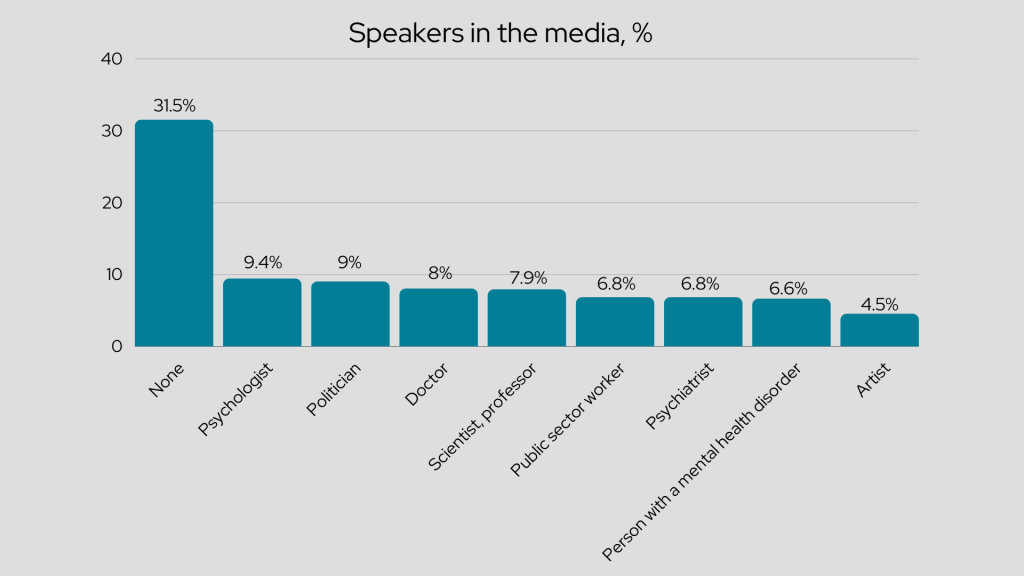
Compared to other groups, there are fewer journalistic pieces in which no person was interviewed (31.5%). This means that the media tends to cite someone on mental health topics – in this case, the graph is dominated by expert opinion, especially healthcare workers. Psychiatrists, psychologists, and academics tended to talk about mental health from a scientific perspective with the goal of informing the public about both specific mental disorders and their destigmatization, and about the emotional state society is in during quarantine and the pandemic overall. Meanwhile, actors in the political arena mentioned mental health specifically in terms of quarantine restrictions, including deteriorating public health and wearing masks.
The voice of people with mental disorders can be heard in 6.6 percent of publications on mental health. In most of the them, the speakers shared their experiences with mental disorders (most often mentioned are depression, anxiety disorders), often raising questions about public stigma and the functioning of the Lithuanian health system in relation to mental disorders.
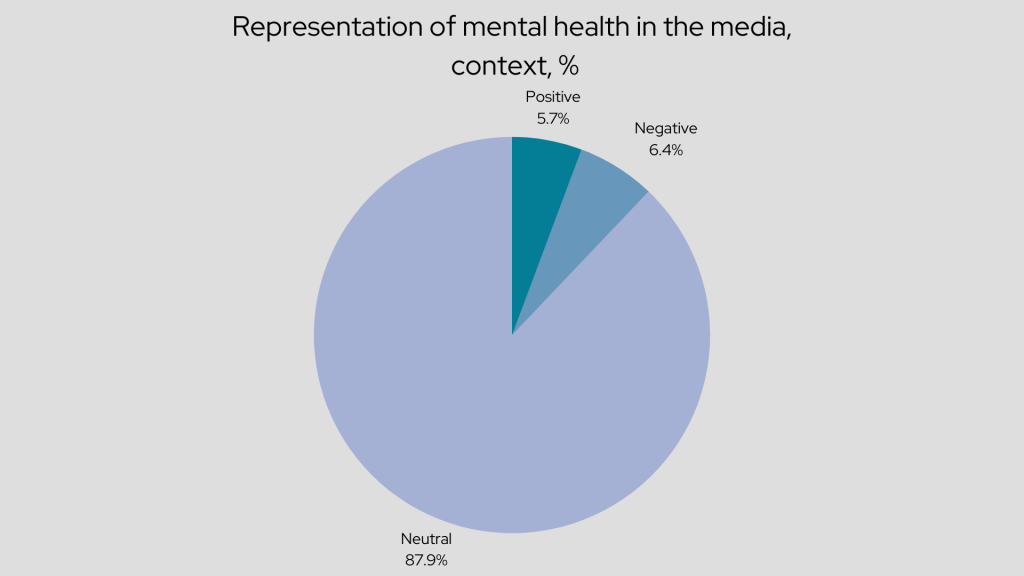
The portrayal of mental health disorders in the media is the most neutral of all the groups studied, which is partly due to the informational way of speaking being dominant. The numbers of positive and negative publications are approximately equal; however, the number of negative publications is slightly higher than that of positive ones. Negative content is mostly of criminal nature (40.5% of negative content), characterized by the tendency to link crime with mental health disorders. This contributes to further stigmatization of mental health and generalized treatment of people with mental disorders as dangerous, unpredictable.
However, as society becomes more open about mental health, there is also more balance in the media. Dominant positive topics include stories of people with mental health problems (36.4% of positive publications), integration (17.1%), as well as public health during quarantine (16.5%). Compared to most other research groups, there are also more journalistic pieces that actively try to break stereotypes about mental disorders (4.3% of all works).
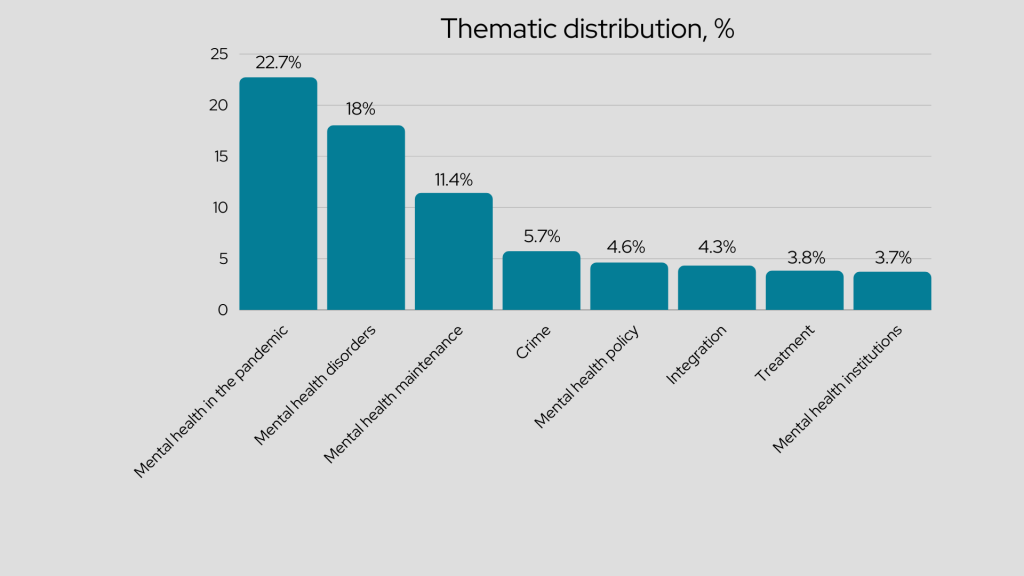
Because of COVID-19, mental health has been the subject of much discussion this year. Topics of mental disorders were also naturally abundant due to their relevance during the pandemic. As mental health concerns increased during quarantine, the discussion increasingly included not only previously dominant individual stories and informational messages, but also the concern for public health. This has led to an increase in the amount of content on mental health and the quality of the discussion over the course of the year.
The remaining topics, with the exception of crime, focused on the status of Lithuanian mental health system and mental health institutions, as well as conditions for people with mental disorders to receive treatment and reintegrate into society.
Unlike many other groups, articles (39.8%) and press releases (29.2%) are most prevalent genre wise. This trend can be seen in regards to each topic, except for crime, where besides articles (43.4% of criminal publications), news reports (22%) and television reports (9.3%) are more frequent.
Sexual orientation
In 2020, 4 778 works on the topic of sexual orientation were analysed in Lithuanian media. In 29.7% of them, the LGBT+ community was the main topic. Out of these works, the topic of discrimination and hate speech towards LGBT+ was most frequent (21.6%). Other prominent topics included the relationship between the LGBT+ community and religion (11.4%) (mostly after when Pope Francis spoke out on gender-neutral partnership) and LGBT+ marches and protests in various countries of the world (10.1%), especially in Lithuania, Poland and Russia.
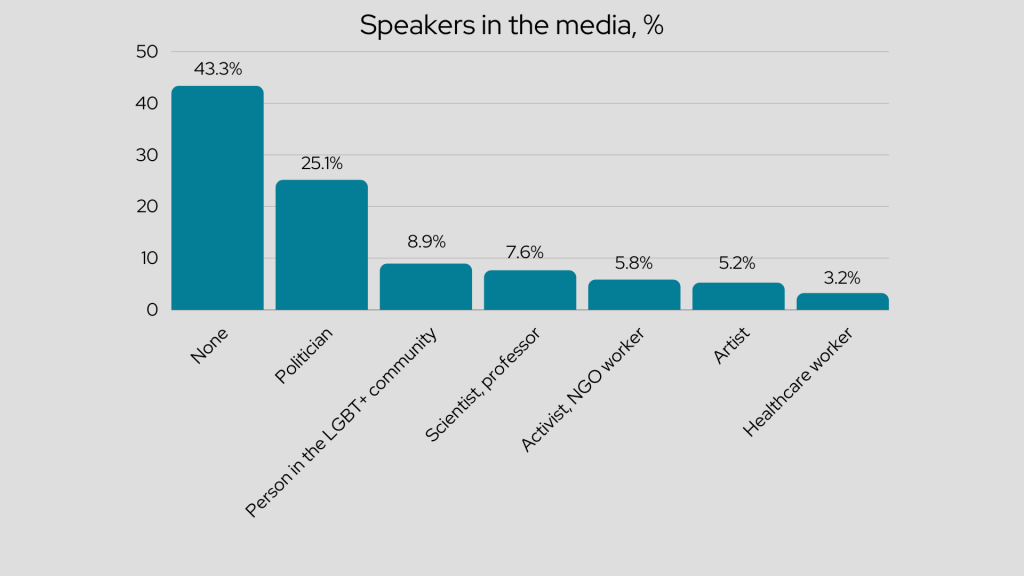
In the media, only political figures are more likely to speak than a member of the LGBT+ community, and they take up a quarter of all publications. Politicians often speak in an abstract way regarding sexual orientation, generally calling for or denouncing “LGBT rights”. However, in the context of parliament elections, politicians got more specific when discussing gender-neutral partnership (27% of works in which politicians spoke). Meanwhile, activists fighting for the rights of the LGBT+ community spoke the most on hate speech and discrimination (49.3%). Members of the LGBT+ community as a whole were mostly interviewed when talking about their coming out stories or experiences, difficulties, achievements (30.5%); they were also cited on the topic of LGBT+ representation (15.7%) and discrimination (13%).
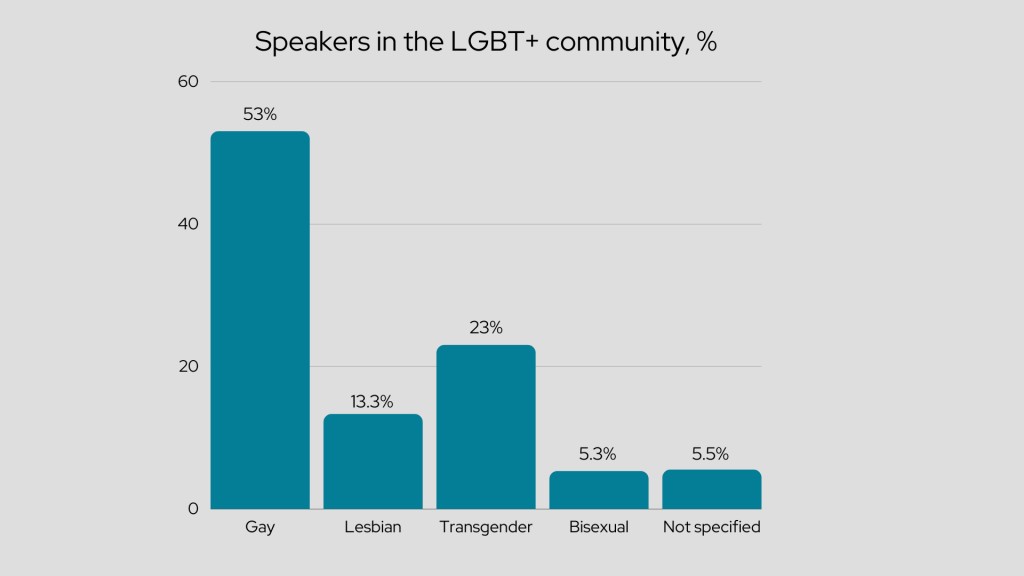
Among the LGBT+ community, homosexual men are the ones that are most cited in the media; they mostly speak about discrimination and hate speech, when talking about their personal stories or LGBT+ marches and protests. Transgender and bisexual individuals, in turn, are majorly cited in the context of personal coming out stories. Homosexual women – in publications about discrimination, personal stories, civil partnership. Finally, individuals with unspecified identities spoke on the topic of LGBT+ representation.
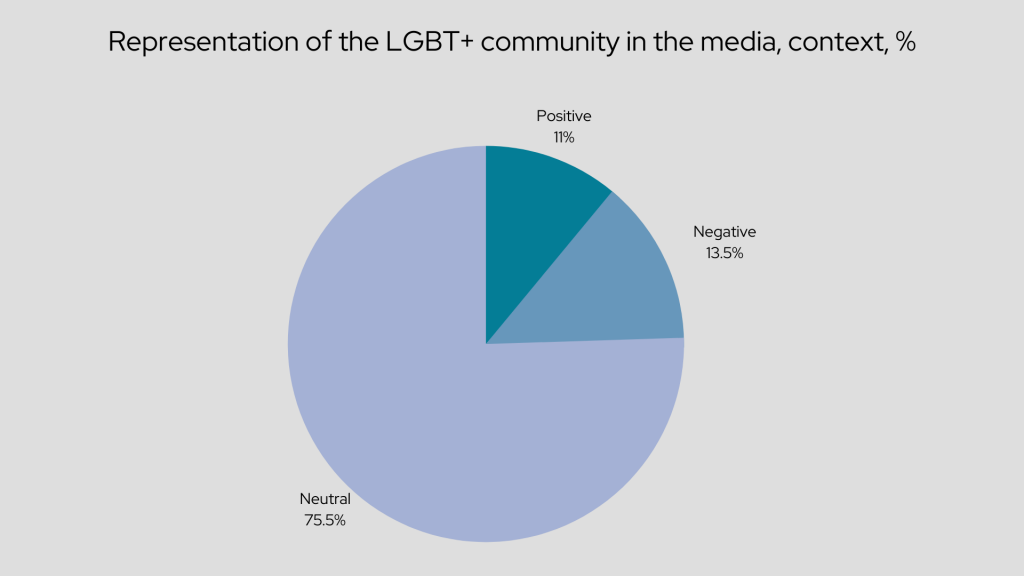
Neutral publications can be found most often regarding sexual orientation, and the ratio of positive to negative context is similar, although the latter is higher. Of the negative content, as many as 32.1 percent also actively promoted negative stereotypes about sexual orientation, the LGBT+ community and the nature of its activities. Negative journalistic works did not have one or more dominant themes, but the narratives used to describe the LGBT+ community in political and human rights discussions are repetitive. This includes the destruction of statehood and family due to the imaginary “LGBT ideology”, conspiracy theories about the alleged LGBT propaganda carried out by the European Union, and associations with perversion. More than a third (36.8%) of negative works appeared through the same four media outlets, which tend to publish intolerant content.
Meanwhile, positive publications were more likely to talk about discrimination against the LGBT+ community (17.5% of positive news items), representation (14.4%). Also, 22.2 percent of positive pieces have been trying to actively break down stereotypes about the LGBT+ community, often in a constructive manner and by providing a new approach to the problems faced by those who are unable to come out or experience social rejection after coming out.
In regional news outlets, LGBT+ representation is in a worse situation – here LGBT+ is one of the least represented groups monitored by Media4Change (6.9% of all works on sexual orientation). In addition, there are only 3.9% of positive publications and twice as many negative publications compared to the total number of negative content (26%).
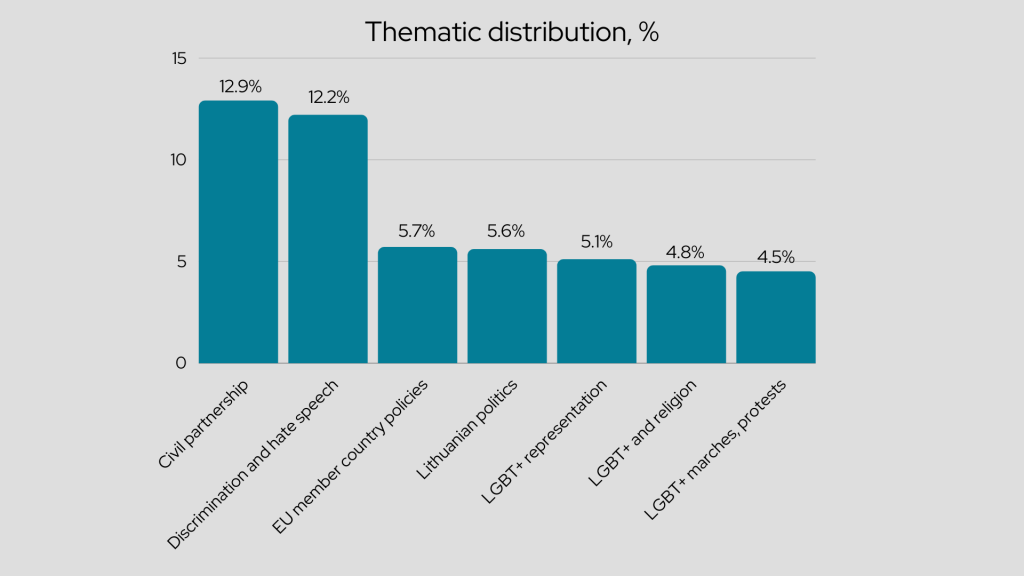
Among the most recurring thematic contexts in 2020 was the issue of gender-neutral partnership, which was most discussed during the electoral campaigns. The situation of the LGBT+ community in terms of hatred and intolerance in society was discussed to a similar extent. A certain balance of opinions has been found in the media in regards to most of the topics, although in some cases the ratio of positive and negative works is unbalanced: for example, LGBT+ in Lithuanian politics (12.4% positive and 23.3% negative), family, paternity and maternity (12.5% positive and 25% negative) and education (27.3% positive and 52.3% negative).
Muslims
In 2020, 4 886 news items about Muslims or Islamists were found. The keyword “Muslim” appeared in 3 710 works and “Islamist” in 1 651 works. The term “Islamist” was used almost exclusively to describe the actions of extremist military forces or radical groups. Of the 478 works that mentioned both keywords, 10 used them synonymously, directly linking the religious and cultural community to radicalism.
In 27.2 percent of journalistic works, Muslims (20.7%) or Islamists (6.5%) were the main topic of the piece. After dedicating the article to the Muslim community, 26.1 percent of them were about discrimination against Muslims, 22.5 percent about terrorist acts, and in 14.4 percent Muslims appear in the context of politics between the East and the West.

When talking about Muslims, expert opinion is heard the most: political figures, members of law enforcement, soldiers and scholars are cited most often. Muslims or representatives of the Muslim community were cited by 3.3 percent of media pieces, two thirds of which appeared in foreign context and one third – in Lithuanian context. Muslims spoke out on the topics of culture and discrimination against Muslims the most.
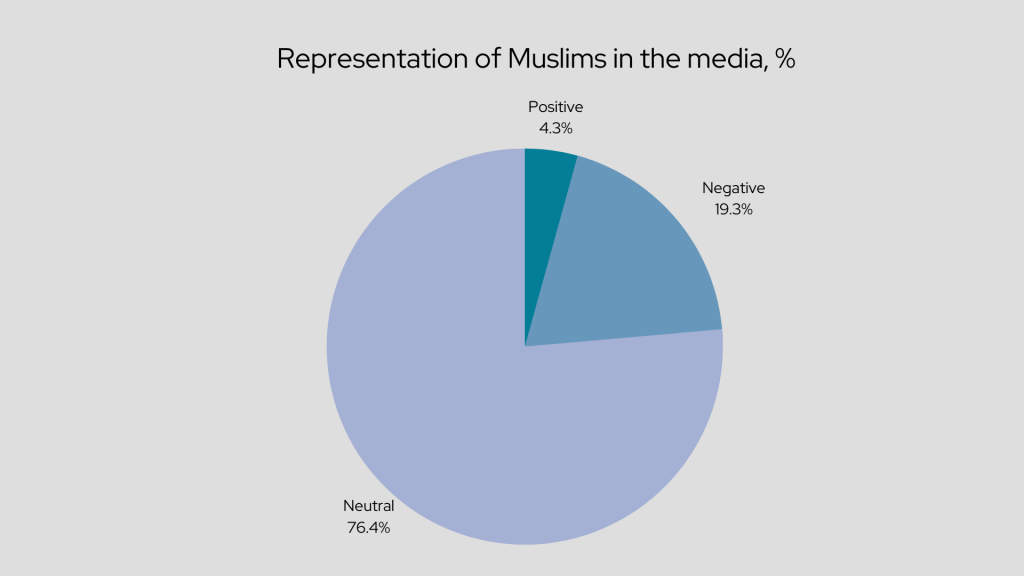
In 2020, there were 4 times fewer positive pieces than negative. Compared to 2019, when there were 3% of positive and 15% of negative items, the ratio remains similar. Negative remarks about Muslims are often closely related to the topic of migration, and the ‘spread’ of Islam to Europe. Muslims are often positioned as the enemy of Western society – although manifestations of this phenomenon can be found throughout all media, its most violent expression appears on non-systemic media platforms. Using stereotypes based on superficial perceptions of Islam and Muslim culture and taking advantage of the fact that the culture is not so well known to the public, these platforms threaten the reader with the Islamization of society.
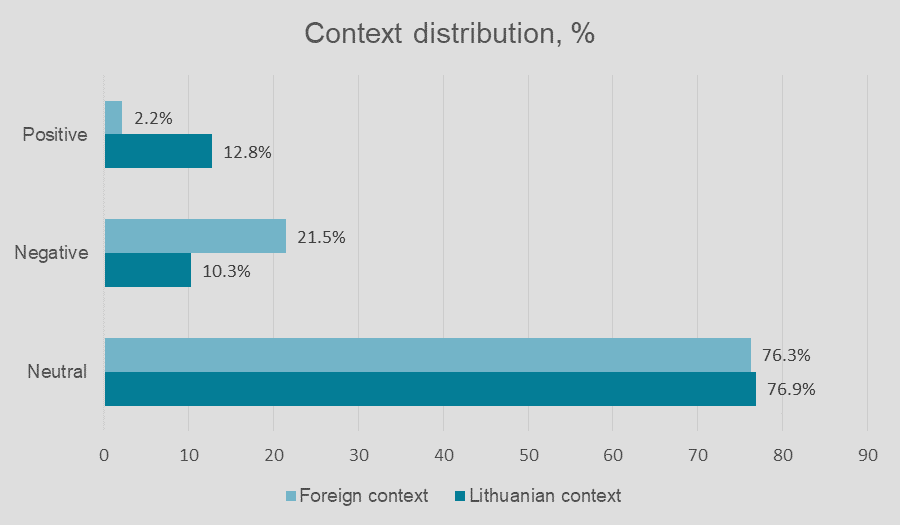
Regarding content in either foreign or Lithuanian context, differences in the positive-negative context can be observed. Almost 6 times more positive pieces were found in the Lithuanian context than in the foreign context. Meanwhile, negative publications in the foreign context were twice as many compared to the Lithuanian context. These figures are illustrated by the thematic differences between foreign and Lithuanian contexts in the representation of Muslims in the media.
Foreign context
In the Lithuanian media, Muslims mostly appear in a foreign context (80.5% of journalistic works). Out of these, 69.5 percent are of the report genre – this means that half of the pieces about Muslims in the Lithuanian media report on foreign news and events. Foreign reports are mostly neutral (78.5%), and refrain from using evaluative wording or perpetuating stereotypes about the Muslim community. However, the genre does not in itself guarantee impartiality – a headline or text that seeks to draw attention through negative associations also contributes to the negative image of Muslims in the media (for example, “A knife-armed man calling Allah’s name shot in France”).

Political and violence-related contexts dominate the foreign-based content. Acts of terrorism, both by radical Islamist groups and radical anti-Muslim groups, have been the most common in the foreign context. Muslims are also often mentioned in relation to East-West relations, military action in the Middle East and their political implications. Discrimination against Muslims is mainly discussed in the context of the Xinjiang region of China, as well as in Germany, France and Myanmar.
Lithuanian context
Meanwhile, 19.5 percent of the remaining context is of Lithuanian context. Article genre dominates here (42.9% of media in the Lithuanian context) and many of them only mention Muslims. Muslims are the main topic in just 9.8% of articles in the Lithuanian context, mainly in religious or cultural contexts and in relation to the Tatar community in Lithuania.
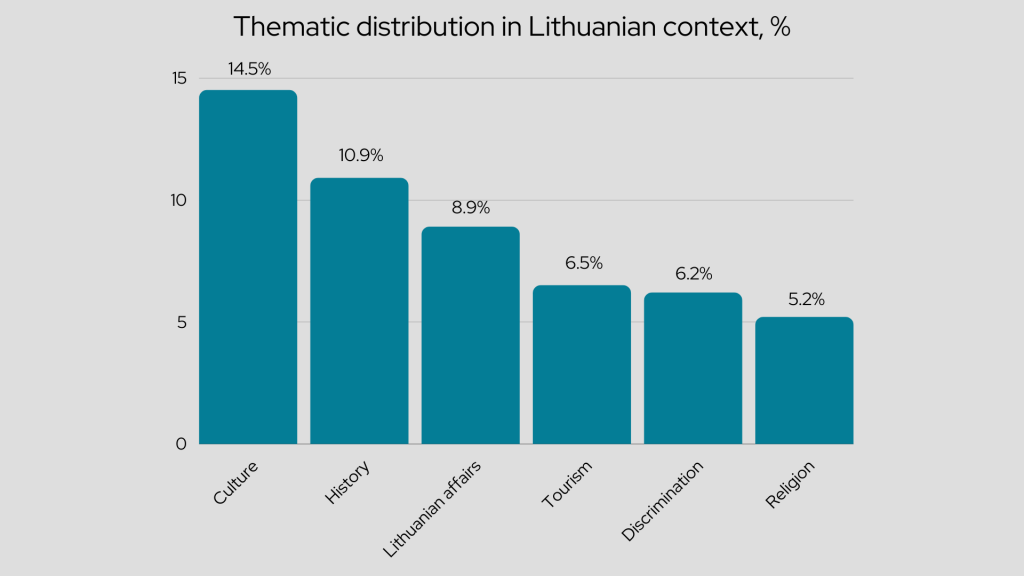
Unlike foreign events, Muslims are more likely to be represented in cultural and historical contexts, for example, by introducing different cultures in Lithuania or introducing Tatar and other Lithuanian Muslim communities. Discrimination against Muslims is mentioned when talking about other groups in society, often war refugees.
Muslims are also the least represented group in regional publications (5.3% of all content on Muslims). In regional outlets, Muslims usually become a part of travel publications or descriptions of the culture and history of different countries.
Ethnic groups
Poles
In 2020, 6 969 journalistic works mentioning the Polish ethnic community were analysed in the Lithuanian media. Of these, in 1 061 works (15.2%), Poles were the main topic of the publication. Political topics were prominent in most of them – both Lithuanian-Polish relations and the situation of Poles in Lithuania – as well as cultural and historical contexts.

The Polish voice could be heard in 4.4 percent of media pieces. Most of those quoted were non-Lithuanian Poles (65.5% of interviewed Poles) – they mostly appeared in cultural contexts: publications about events, Polish culture and famous Polish personalities, as well as political issues during protests or presidential elections in Poland. Meanwhile, the remaining percentage of the Poles interviewed were Lithuanian Poles: they were mainly cited when discussing Lithuanian and Polish politics, the situation of the Polish community in Lithuania, as well as historical topics.
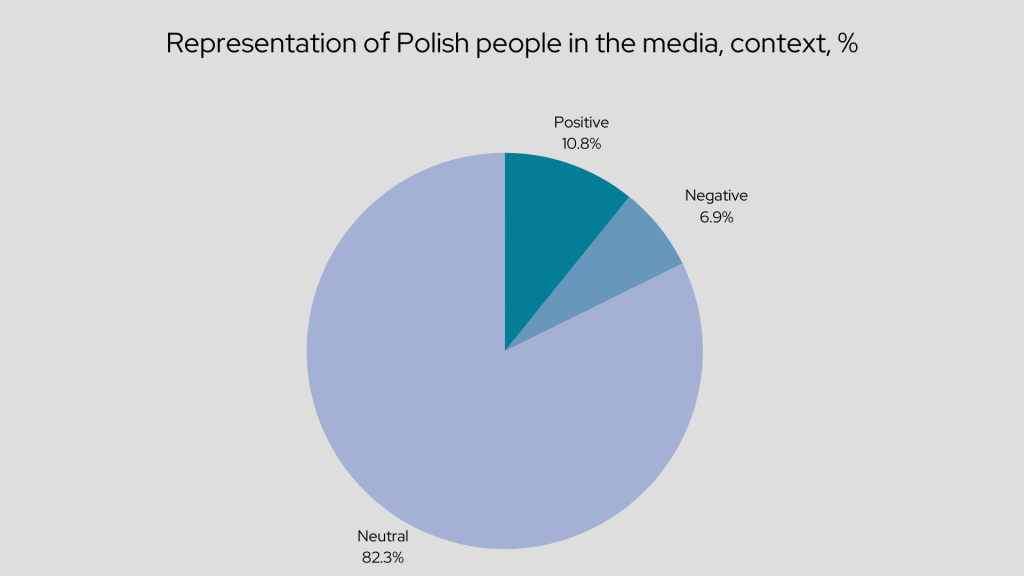
In regards to Poles, neutral context prevails and the positive content outweighs the negative. Almost half (47.8%) of positive content was cultural – the pieces spoke highly of Polish creators in various art forms and prominent personalities who made a significant contribution to the cultural rise of the Polish nation. Another 18.1 percent of positive works spoke of the Polish community in a historical context – such publications often appeared on dates important to both nations.
Meanwhile, negative pieces were mostly historical (44.6% of negative works); in them, negative remarks are mostly related to historical military conflicts between Lithuania and Poland. 26 percent of negative items were of criminal nature – emphasizing nationality in publications describing violations of the law. Poles are most often mentioned as culprits of car accidents or singled out as having problems at the border in the Lithuanian context; meanwhile, more resonant cases emerge in the foreign context.
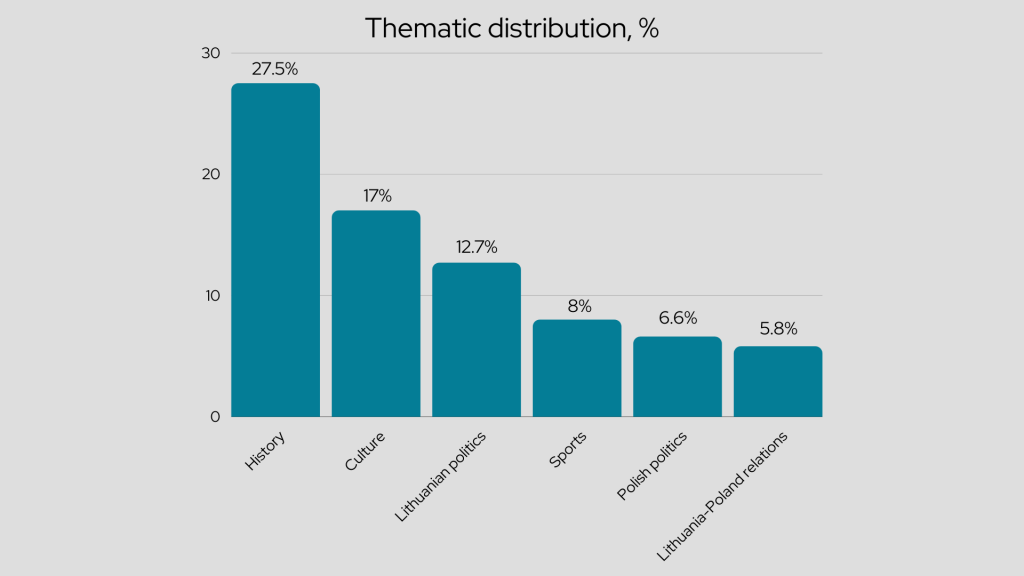
In the Lithuanian media, Poles are mostly portrayed in historical contexts. Despite the existence of both negative and positive historical narratives in relation to Poles, most historical representations are neutral (81.7% of historical works), and the positive and negative contexts are almost equally distributed (7.1% positive, 11.2% negative). Cultural contexts – publications about Polish music, films, literature – in turn have a significantly higher percentage of positive context than negative (33.8% positive, 0.9% negative).
Regarding the situation of the Polish community in Lithuania in general, there was a tendency to portray Poles more positively (28.8%) than negatively (8.7%). Though, in terms of specific issues, the numbers get closer: regarding spelling of street names and names, Poles were depicted 6.2 percent positively and 7.7 percent negatively. When talking about the education of ethnic communities – 14 percent positively and 5.3 percent negatively. It is important to note, however, that neutrality dominated all of these topics. The Lithuanian Polish community was not discussed very abundantly in the media and the portrayal was quite momentary – the problems that arose did not stay long in the news cycle.
Russians
In 2020, 8 979 media pieces mentioning the Russian ethnic community were analysed in the Lithuanian media. Of these, in 679 works (7.6% of all), Russians were the main topic, mostly about the Russian society, politics and culture.
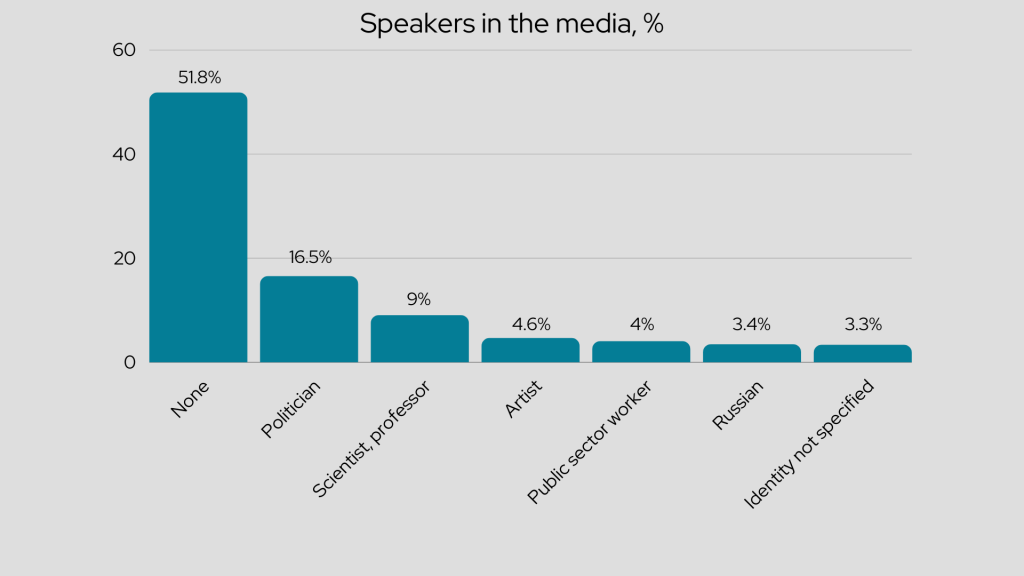
A Russian or a representative of the Russian community was interviewed in 3.4 percent of journalistic works. Out of those cited, 22.3 percent were Lithuanian Russians, and mostly spoke on cultural topics (44.7% of content in which Lithuanian Russians were cited). Culture also accounted for a significant percentage of works quoting foreign Russians (29.6% of non-Lithuanian Russian citations), but there was more diversity here – the Russian voice was also heard on Russia’s domestic policy issues (21.7%), especially in regards to the amendment of the constitution, and in topical issues in sports (14.8%).
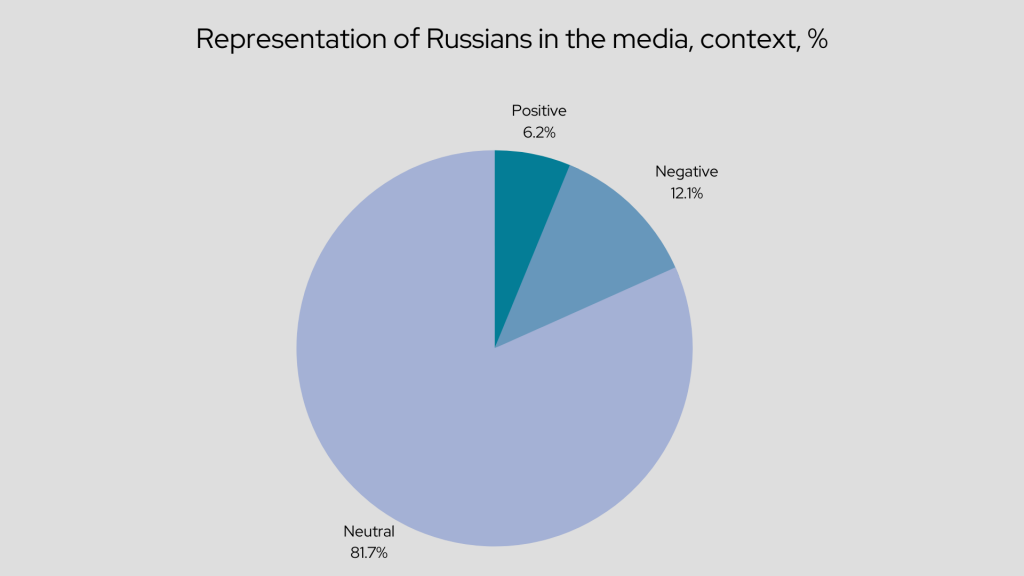
Neutrality in terms of Russian representation in the media can be seen most often, but the negative context outweighs the positive. 17.3 percent of negative pieces talk about Russian politics, especially in the context of Russia’s foreign policies. Looking further, the profile of negative publications is very similar to that of Poles – 27 percent negative publications are historical, talking about the nineteenth and twentieth centuries, and 24 percent – criminal. Though, the negative representation of Russians in historical publications is usually limited to mentioning historical circumstances, or someone recounting their experience. Meanwhile, criminal publications, as is the case for many other groups, emphasize a certain part of a person’s identity (in this case, ethnicity). Media items on crime do not shy away from portraying Russians in a mocking way:
The composition of positive content is also easily predictable: 42 percent of the pieces were cultural, often having the author or interviewee admire Russian classics or Russian personalities in culture and science. Meanwhile, historical works occupied a little more than a quarter of positive context (26.8%) – in these, the historical actions of the Russian government were not attributed to Russians as a whole, and local communities and personalities were remembered with respect.
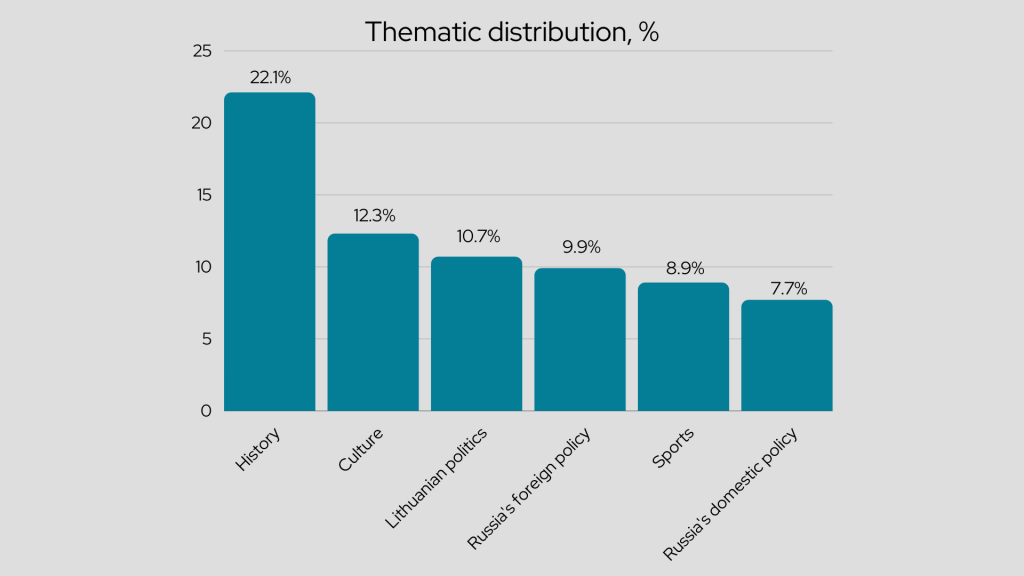
Looking at the thematic contexts in which the Russian community emerged in 2020, it can be seen that historical and political themes stand out the most. The political dimension is dominated by short informational reports – the topic of Russia’s foreign policy consists of 77.8% reports, the topic of Russia’s domestic policy – 59.4 percent, with the most relevant being the poisoning of the member of Russian opposition Alexei Navalny. Genre wise, the situation is similar regarding the politics in Lithuania, where 56.8% media works are news reports. Reports also account for the majority of sports (68.9%) and criminal publications (80%).
In the historical context, Russians are mostly written about in articles (52.4%), mentioned in interviews (12.4%), and in cultural contexts – in press releases (33.8%) and articles (24%).
Jews
During the year, 10 757 works mentioning the Jewish community were recorded in the Lithuanian media – the most of all monitored groups. Jews also have the highest percentage of publications in which the community is the main topic (35.3 percent). Such works mostly focused on Jewish history in Lithuania (39.4% of works in which the Jewish community is the main topic) and memorials (21.1%).
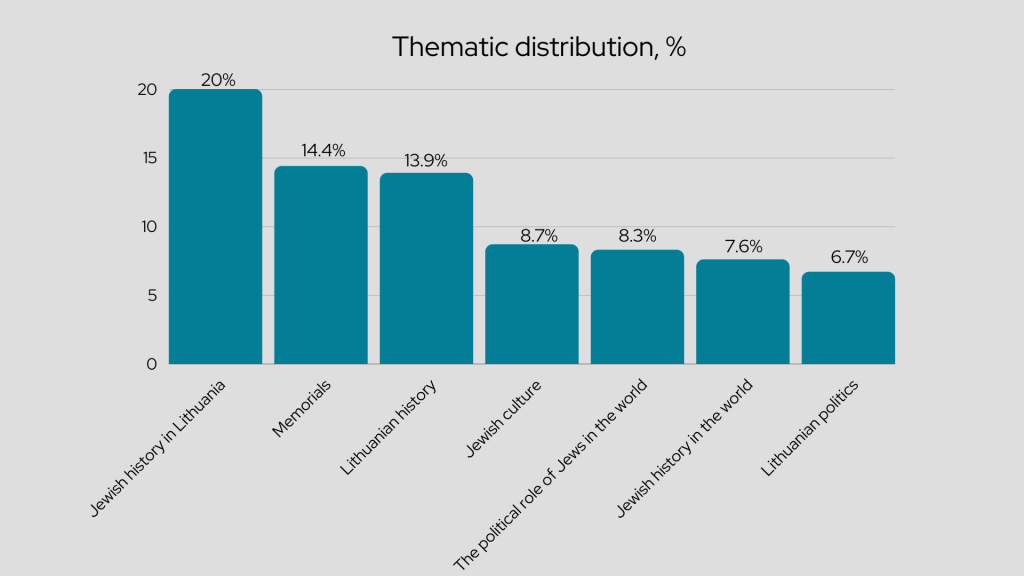
The situation is similar when looking at overall thematic contexts, the most prominent topic being history. One fifth of all works tell the history of Litvaks in different periods of Lithuanian history, usually in the 20th century. 25.6 percent these works appear in regional publications, where locals, historians and public figures share their memories of the country’s Jewish communities and their contributions to the local community. The Vilnius Gaon, whose year was commemorated in 2020, is mentioned in a total of 1 826 media works (17% of all works about Jews), in various cultural, religious and historical contexts, educating the public about his significant contribution to Jewish culture and Judaism traditions. The history- and memory-oriented narratives remained dominant in all media categories monitored: internet (51.6%), national outlets (56.5%), news agencies (55.1%), radio (60.4%), regional outlets (70.6%), television (53.7%) and magazines (59.5%).
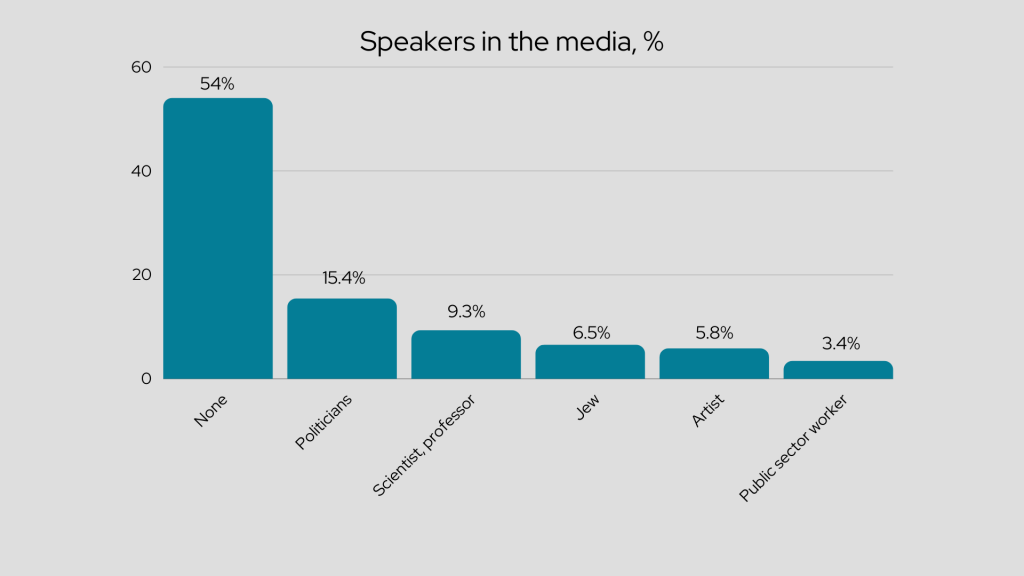
As with all other groups, most publications do not feature any person’s voice. Politicians, who were the most frequent speakers in publications about the Jewish community in 2020, mostly spoke about Israeli politics (23.1% of the pieces in which politicians spoke) and at the unveilings of memorials and monuments to Jews and rescuers of Jews during the Holocaust (20.5%). The majority of the third category consisted of historians who spoke in historical articles and interviews (57.9% of the works in which experts were interviewed).
Jews and representatives of the Jewish community were also cited in publications about Jewish history (40.2% of works that spoke to a member of the Jewish community), as well as on Jewish traditions and cultural heritage (14.7%).
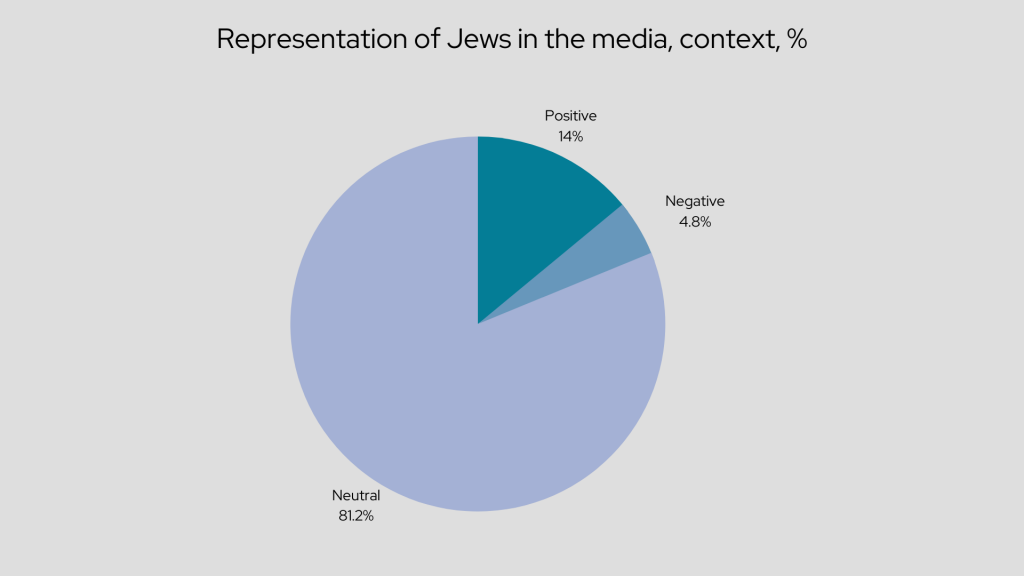
The portrayal of Jews in the media remains the best compared to all monitored groups: the number of positive pieces is the highest here, and the number of negative ones is the lowest. History, as a topic, can be seen in most of the positive works – 49 percent of positive works are historical, and another 16.9 percent spoke about ways to commemorate and honour the Jewish community in the form of monuments or memorial plaques both in local communities and nationally. 20.1 percent of positive pieces also spoke highly of Jewish cultural personalities, national traditions and legacies, especially in regards to education.
Alternatively, most of the negative content focused more on Israel’s political role in the world and particularly in the Middle East (56.2% of negative pieces), where the compound “Jewish state” is often used as a synonym for Israel. That in itself could be neutral, but 54 percent of publications that have used this compound used it in a negative context. Negative context was also seen in regards to the alleged political role of the nation – that is, conspiracy theories about the imaginary power of the Jews. Another 21.9 percent of the negative works were historical, characterized by the fact that they spoke stereotypically, in a generalized way, about Jews, or obviously incited hatred against the whole nation.
Roma
In 2020, 1 567 journalistic works about the Roma were analysed. In 16.7% of them the Roma ethnic community was the main topic. Such publications focused on the situation of the Roma in Lithuania (45.6% of the works in which the Roma were the main topic), where the demolition of the Vilnius encampment received the most attention.
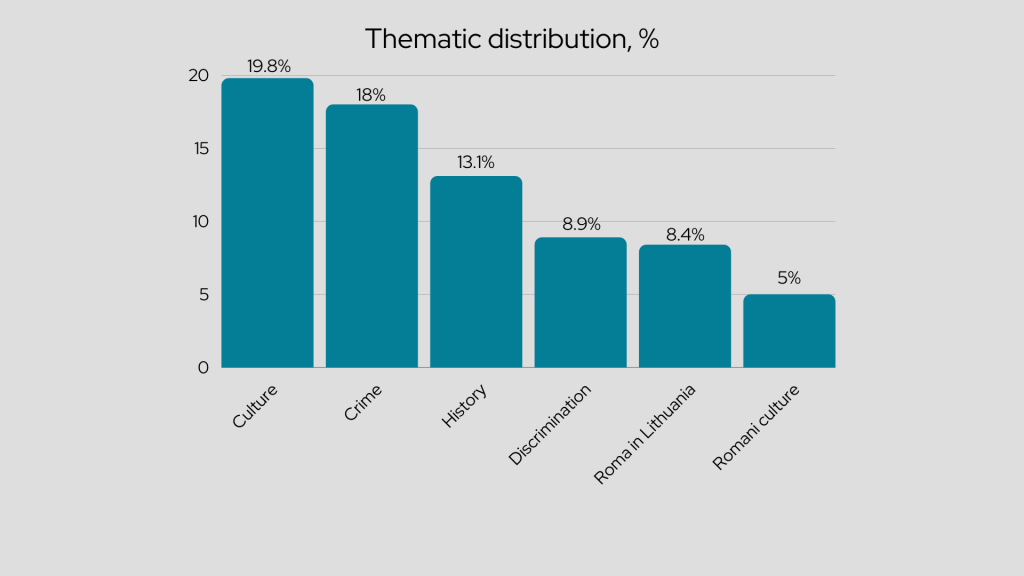
However, looking at the subject matter of all news items on the Roma, we see a different picture – cultural and criminal topics have the highest indicators. Although abundant cultural and historical contexts are quite common in the thematic distribution when representing ethnic communities, in the case of the Roma, history and culture is not expanded on – in many of these publications, the Roma are merely mentioned among many other groups. Meanwhile, the criminal context indicator stands out as the highest among ethnic communities and the second highest among all monitored groups – and the Roma are given a key role in these publications. Bearing in mind that 90.8 percent of criminal publications are negative, it is clear that almost a fifth of the media discourse on Roma only continues to perpetuate negative public attitudes towards the Roma community. Publications on crime also do not shy away from using particularly strong anti-Roma language, and the mention of nationality or the colour of their skin becomes just another sensational detail of the article:
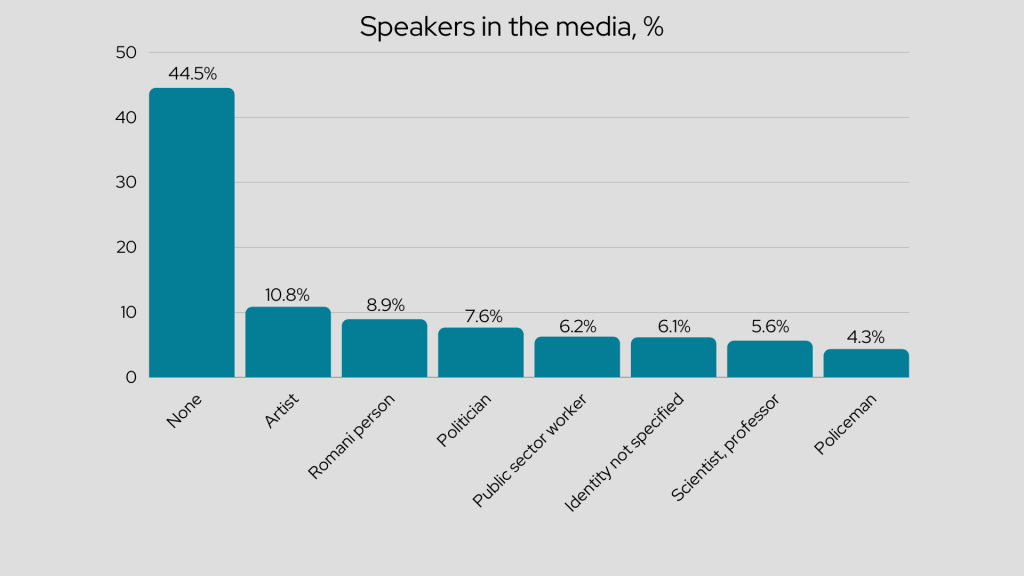
In 2020, the ones cited in publications mentioning the Roma ethnic community the most were artists (10.8%), although in almost all of them Roma were only briefly mentioned among other communities or peoples’ cultures represented at events or local history. Meanwhile, the Roma were interviewed in 8.9 percent of publications – ten percent less than last year. Though, one trend has not changed – the most frequently quoted Roma remained singer Radži and the leader of the Roma ensemble Sare Roma, the chairman of the Roma community, Ištvan Kvik. The Roma were most often cited when talking about Roma culture (31.4% of works citing representatives of the Roma ethnic community) and the situation of Roma in Lithuania (37.9%), with particular emphasis on the Roma community’s own initiatives: the Roma Culture Festival and the newly opened Roma restaurant. The Roma interviewed in these works took the matter of representation into their own hands – as many as 49 percent of the works that interviewed Roma broke stereotypes.
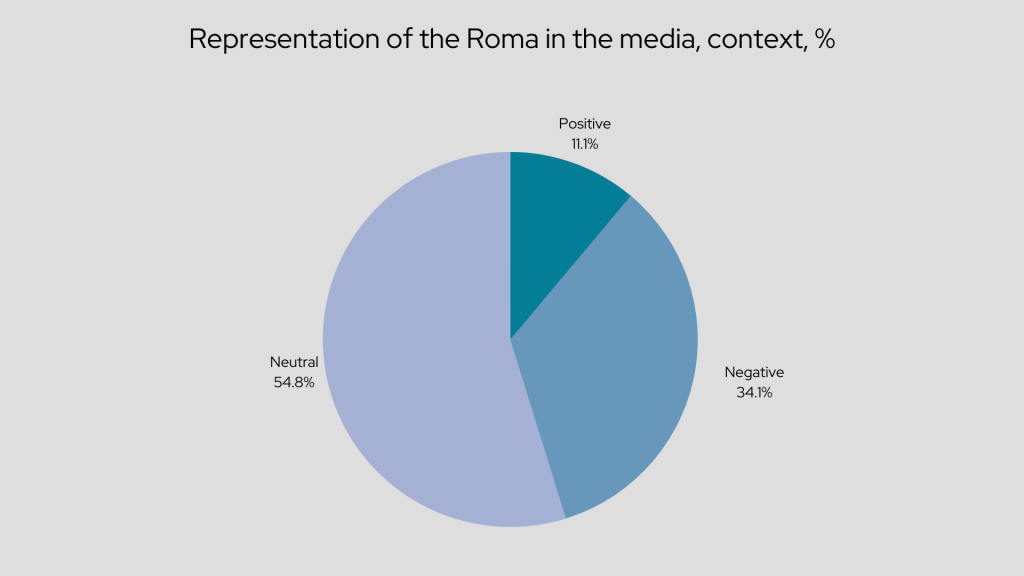
Roma representation remained in the worst situation of all the monitored groups in 2020 as well. The amount of neutral content barely crosses the 50 percent barrier – and the rest does not consist of positive pieces. 34.1 percent of negative publications illustrate the deep-rooted attitudes of Lithuanian society, which criminalize, demonize and mystify the Roma – as much as 47.9 percent of negative works about the Roma are crime-related. The Roma community is still treated as foreign to the state and society: the narratives about stealing social services or a “Roma curse” that manages to fool the unsuspecting passer-by are not uncommon. Such image of the Roma does not have a sufficient counterweight – positive pieces about the Roma can be found three times less in the media (11.1%). Many of them (32.2%) talk about the situation of the Roma in Lithuania and the language of discrimination and hatred, and another 36.7% are cultural – celebrating rich Roma culture, music and cuisine.
7.7 percent of all content aimed at destroying the aforementioned established attitudes towards the Roma community, and 17.6 percent actively maintained and strengthened them, most of them being about the alleged predisposition of the Roma to crime.
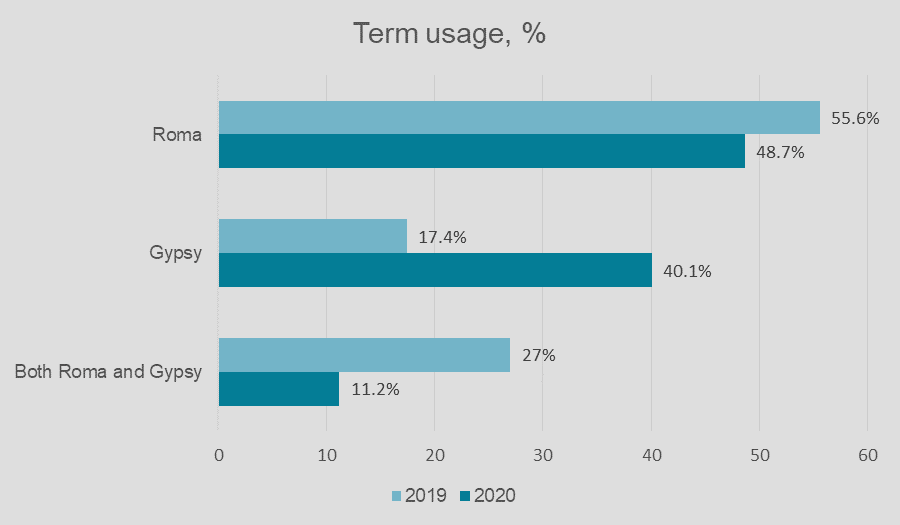
Looking at the relationship between the terms ‘Roma’ and ‘gypsy’ in the media, the use of the term ‘gypsy’ increased in 2020 compared to 2019. The use of this term is also related to context: 47.5% publications that used only the term ‘gypsy’ were negative (3.5% – positive), while 24.9% using only the term ‘Roma’ were negative (11.5% positive). This makes it two times more likely to find negative articles using ‘gypsy’ compared to ‘Roma’.
Results
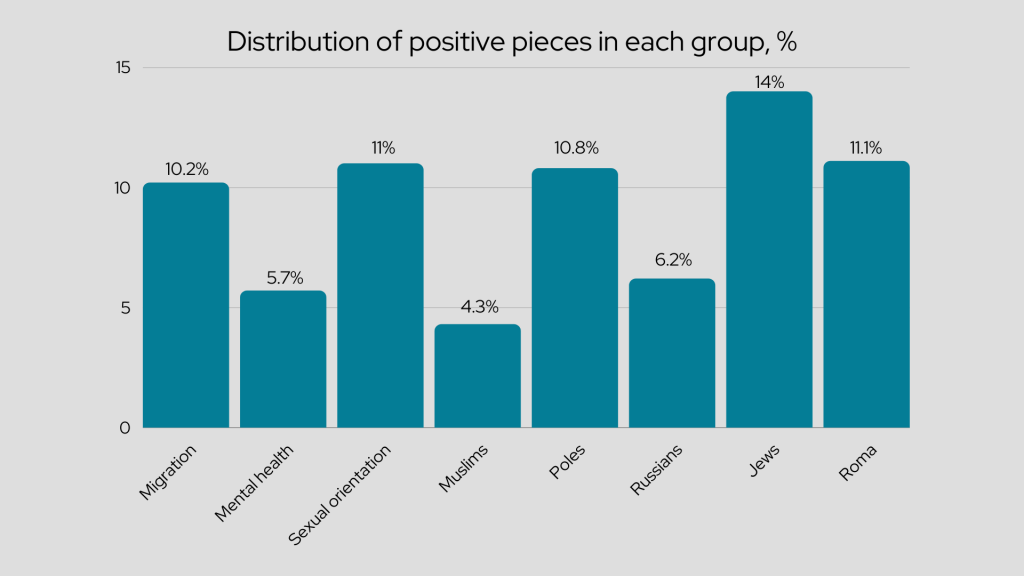
Distribution of positive context (% of content about each group). The group with the biggest percentage of positive pieces in 2020 was Jews, and the smallest – Muslims.
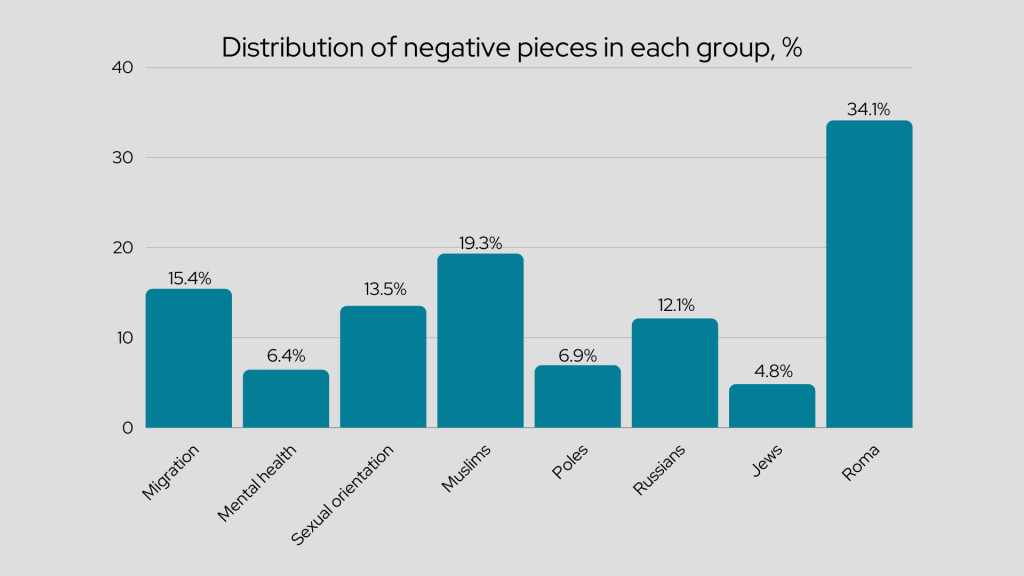
Distribution of negative context (% of content about each group). The group with the biggest percentage of negative pieces was the Roma, and the smallest – Jews.
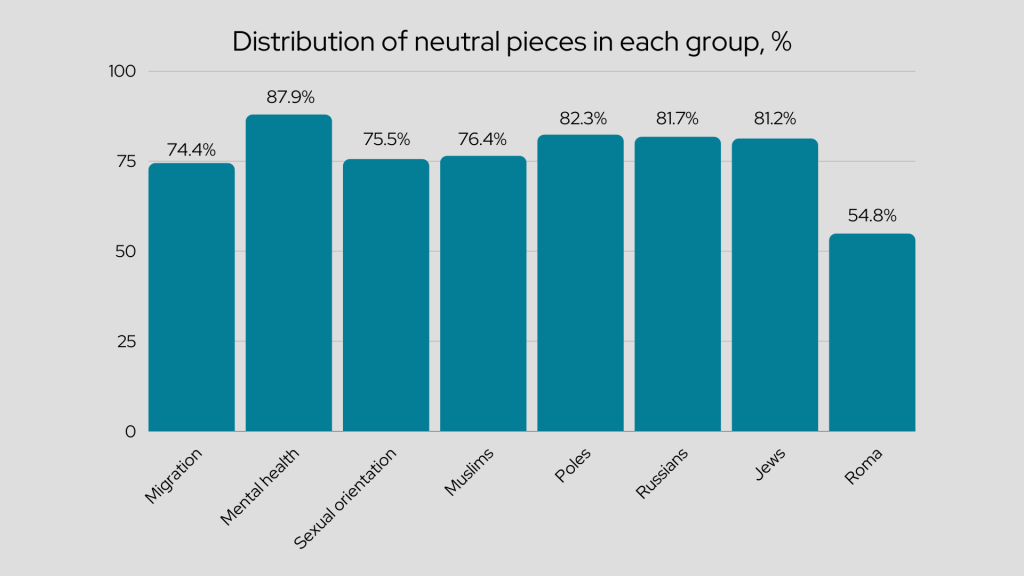
Distribution of neutral context (% of content about each group).
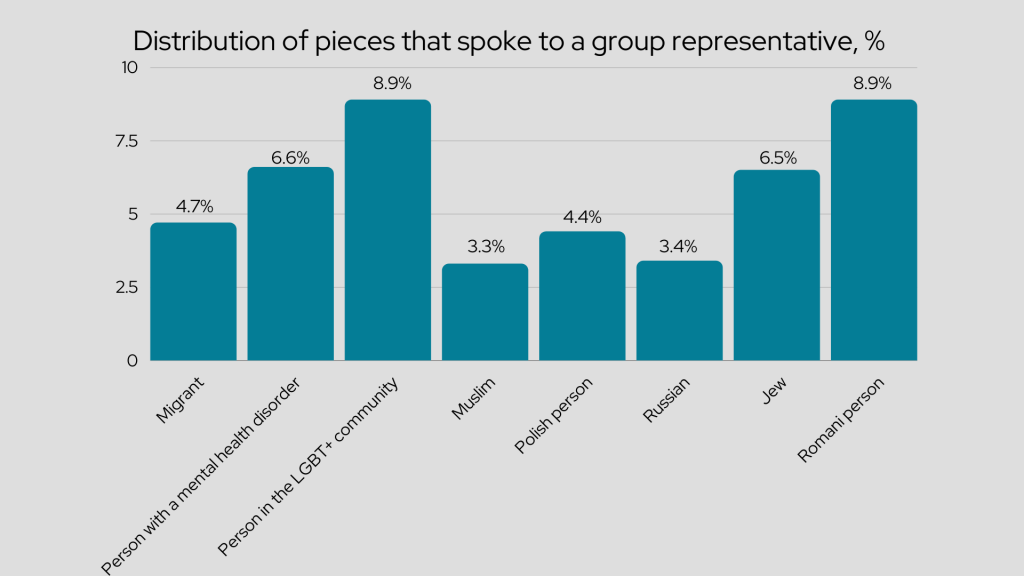
Percentage of interviewed groups (% of content about each group). The group that was heard the most in regards to the number of publications about said group was the LGBT+ community and the Roma ethnic community.
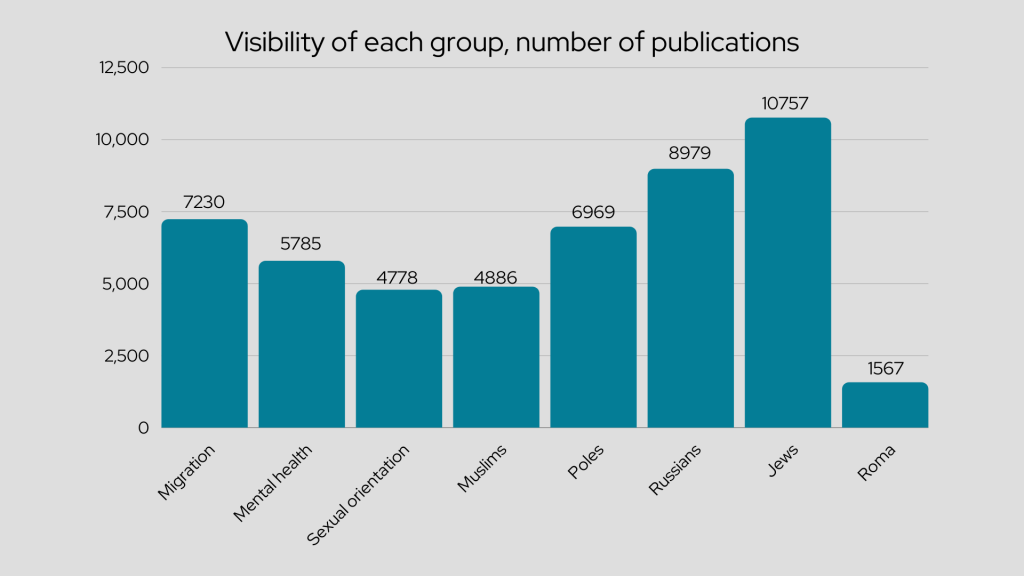
The visibility of monitored groups in the Lithuanian media.
In 2020, 50 951 journalistic pieces were analysed.
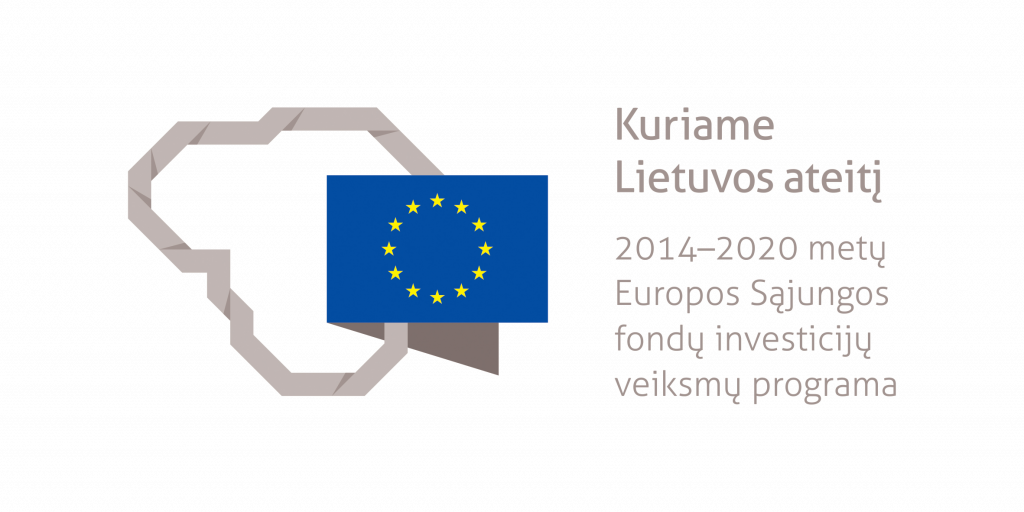
The ongoing media monitoring is part of the project “Inclusion of Representatives of National Minorities in the Labor Market”. The project is implemented together with the Department of National Minorities under the Government of the Republic of Lithuania. Funded by the European Social Fund.
Monitored media outlets*
National outlets
7 meno dienos, Akistata, Apskaitos, audito ir mokesčių aktualijos, BCC paper (anglų kalba), Bičiulystė, Buhalterija: apskaitos ir mokesčių apžvalga, Diabetas, Kaimo laikraštis, Karštas komentaras, Kurier Wilenski, Laisvas laikraštis, Lietuvos aidas, Lietuvos rytas, Lietuvos sveikata, Mokslo Lietuva, Mūsų RESPUBLIKA, The Baltic Times, Vakaro žinios, Valstiečių laikraštis, Verslo žinios, Šiaurės Atėnai, Ūkininko patarėjas, Žaliasis pasaulis, Žalioji Lietuva, Литовский курьер, Обзор
Magazines
A-ZET (Lietuva), Acta Medica Lituanica, Audio & Video pasaulis, Auto Bild, Aviacijos pasaulis, Baltic Railways Magazine, Best in Lithuania, Centras, Cosmopolitan, Edita, Ekonomika ir visuomenė, Farmacija ir laikas, Geras skonis, Geros savijautos žurnalas 36,6°C, Gydytojų žinios, IQ Life, IQ. The Economist, Internistas, Investuok, Ji, Jūra Mope Sea, Kelionės ir pramogos, Keturi ratai, Kultūros barai, L Officiel, Laimė, Lietuvos akušerija ir ginekologija, Lietuvos bendrosios praktikos gydytojas, Lietuvos chirurgija, Lietuvos gydytojo žurnalas, Lietuvos oftalmologija, Literatūra ir menas, Mamos žurnalas, Mano namai, Mano patarimai, Mano sodyba, Mano ūkis, Mažylis, Medicina, Medicinos teorija ir praktika, Mieste, Mokslas ir technika, Moteris, Moters savaitgalis, Moters savaitė, Muzikos barai, Mūsų girios, Mūsų krepšinis, Namas ir aš, Namie ir sode, National geographic Lietuva, Neurologijos seminarai, Otorinolaringologijos aktualijos , Ozonas, Panelė, Pediatrija, Prie kavos, Psichiatrijos aktualijos, Psichologija tau, Pulmonologija, imunologija ir alergologija, Rasos, Restoranų verslas, Savaitė, Savivaldybių žinios, Slauga. Mokslas ir praktika, Statyba ir architektūra, Statyk, Stominfo, TOP moterys, Tavo vaikas, Top Gear, Valstybė, Veidas, Verslas ir politika, Verslo klasė, Virtuvė. Nuo…Iki, bzn start, Šeimininkė, Švietimo naujienos, Žmonės, Žmonės. Legendos, Экспресс-Неделя
Regional outlets
Alio Jonava, Alytaus naujienos, Anykšta, Atspindžiai, Auksinė varpa, Banga, Biržiečių žodis, Bičiulis, Būdas žemaičių, Dainavos žodis, Darbas, Draugas, Druskonis, Dzūkų žinios, Elektrėnų kronika, Elektrėnų žinios, Etaplius savaitraštis, Galvė, Gimtasis Rokiškis, Gimtoji žemė, Giružis, Gyvenimas, Joniškio dienos, Kaišiadorių aidai, Kalvotoji Žemaitija, Kauno diena, Kazlų Rūdos laikraštis, Klaipėda, Kupiškėnų mintys, Kuršėnų krašto žinios, Kėdainių mugė, Lazdijų reklama, Lazdijų žvaigždė, Merkio kraštas, Miesto laikraštis (Marijampolė), Mūsų Ignalina, Mūsų laikas, Mūsų žodis, Nauja vaga, Naujas rytas, Naujasis Gėlupis, Pajūrio naujienos, Palangos tiltas, Pamarys, Panevėžio balsas, Panevėžio kraštas, Plungė, Plungės žinios, Radviliškio kraštas, Radviliškio naujienos, Rinkos aikštė, Santaka, Santarvė, Sekundė, Sidabrė, Suvalkietis, Tauragės kurjeris, Tauragės žinios, Telšių žinios, Trakų žemė, Tėvynė, Ukmergė, Ukmergės žinios, Utenis, Utenos apskrities žinios, Utenos diena, Vakarinė Palanga, Vakarų Lietuva, Vakarų ekspresas, Valsčius, Vienybė, Vilniaus diena, Vilniaus krašto savaitraštis, Vilnis, Zarasų kraštas, Šalčios žinios, Šiaulių kraštas, Šiaulių naujienos, Šiaurės rytai, Šilalės artojas, Šilelis, Šilokarčema, Šilutės naujienos, Širvintų kraštas, Švenčionių kraštas, Šviesa, Švyturys, Žeimenos krantai, Žemaitis, В каждый дом, Вести Шалчи, Шальчя
Internet
15min.lt, 1psl.lt, 366.lt, 3sektorius.lt, 98.lt, Aidas.lt, Aidas.us, Aina.lt, Akmene.lt, Akmenietis.lt, Aktualijos.lt, Alaus-brolija.lt, Alfa.lt, Alioraseiniai.lt, Alkas.lt, Alusalus.lt, Alytausnaujienos.lt, Alytiskis.lt, Alytus.lt, Alytusplius.lt, Ambuba.lt, Anglija.lt, Animal.lt, Anonsas.lt, Antstoliurumai.lt, Anyksciai.lt, Anyksta.lt, Anykstenas.lt, Apeliacinis.lt, Apiealu.lt, Arsa.lt, Artnews.lt, Asa.lt, Asvyras.lt, Atlikejai.com, Atviraklaipeda.lt, Aukstaitijosgidas.lt, Auto.lt , Auto.plius.lt/Tyrimai, Autoasas.lt, Autobild.lt, Autogidas.lt, Autoledi.lt, Automanas.lt, Autoreviu.lt, Autozona.lt, Balarama.lt, Bankai.lt, Banku-naujienos.lt, Basketnews.lt, Bernardinai.lt, Birstonas.lt, Birzai.lt, Birzietis.lt, Bns.lt (Naujienos), Budas.lt, Buhalteris.lt, Bznstart.lt, Cargonews.lt, Cosmopolitan.lt, Cpva.lt, DJscene.lt, Dainavosgidas.lt, Delfi.lt, Diena.lt, Dopecars.lt, Druskininkai.lt, E-lietuva.net, Ebus.lt, Edieta.lt, Ekoidejos.lt, Ekologija.lt, Ekonomika.lt, Ekspertai.eu, Ekstremalas.lt, Elaima.lt, Elektrenai.lt, Elektreniskis.lt, Elektronika.lt, Eli.lt, Emedicina.lt, EnergyMarket.lt, Esaugumas.lt, Esinvesticijos.lt, Etaplius.lt, Eu2013.lt, Euras.lt, Eurobasket.lt, Eurofootball.lt, Europarl.europa.eu, EuropeanHitRadio.lt , F-1.lt, Faceit.lt, Faktai.lt, Finmin.lt, Flightglobal.com (anglų kalba), Fm99.lt, Fntt.lt, Forex.lt, Futbolas.lt, Games.lt, Gargzdai.lt, Gargzdietis.lt, Gaukfinansavima.lt, Gelbvaik.lt, Gelsistemos.lt, Geopolitika.lt, Geradieta.lt, Gimimas.lt, Grokiskis.lt, Grozioguru.lt, Gyva.lt, Gzeme.lt, Gzi.lt, Harmonio.net, Hrmi.lt, Ieva.lt, Ignalina.lt, Ignalinietis.lt , Ikimokyklinis.lt, Iliustruotasismokslas.lt, Infashion.lt, Infolex.lt, Inovacijos.lt, Interjeras.lt, Itbaze.lt, Jaunimoaidai.lt, Jaunimogidas.lt, Ji24.lt, Jonava.lt, Jonavoszinios.lt, Joniskelis.lt, Joniskis.lt, Jp.lt, Jura24.lt, Jurbarkas.lt, Jurbarkiskis.lt, Kaisiadorys.lt, Kalvarija.lt, Kalvotoji.lt, Kasdien.lt, Kaunas.kasvyksta.lt, Kaunas.lt, Kaunieciams.lt, Kauno.diena.lt, Kaunoaleja.lt, Kaunozinios.lt, Kaunozurnalistai.lt, Kazluruda.lt, Kedainiai.lt, Kedainietis.lt, Kelme.lt, Kelmiskiams.lt, Kksd.lt, Kl.lt, Klaipeda.lt, Klaipedos-r.lt, Klaipedos.info, Klubas.lt, Kmintys.lt, Komentaras.lt, Krastonaujienos.lt, Krepsininkas.net, Krepsinis.net, Kretinga.lt, Kretingiskis.lt, Kretingos.info, Kulturossavanoriai.lt, Kulturpolis.lt, Kupiskenas.lt, Kupiskis.lt, Kurstoti.lt, L24.lt, Laikas.lt, Laisvaslaikrastis.lt, Lakd.lt, Las.lt, Lazdijai.lt, Lazdijuzvaigzde.lt, Lb.lt, Lba.lt, Lietus.fm, Lietuva.lt, Lietuve.lt, Litas.lt, Literaturairmenas.lt, Lkl.lt, Lmt.lt, Lnb.lt, Lprofsajungos.lt, Lrkm.lt, Lrs.lt, Lrt.lt, Lrv.lt, Lrvalstybe.lt, Lrvs.lt, Lrytas.lt, Lsveikata.lt, Ltkatalogas.lt, Lzs.lt, M-1.fm, Madeinvilnius.com, Makalius.lt, Mama.lt, Mamosdienorastis.lt, Mamyciuklubas.lt, Manoakmene.lt, Manodienynas.lt, Manoego.lt, Manojurbarkas.lt, Manokarjera.cv.lt, Manokedainiai.lt, Manokelme.lt, Manonamai.lt, Manopagegiai.lt, Manopsichologija.lt, Manoradviliskis.lt, Manoraseiniai.lt, Manosakiai.lt, Manosveikata.lt, Manoteises.lt, Manoukis.lt, Marijampole.lt, Marijampolieciai.lt, Mazeikiai.lt, Mazeikietis.lt, Mazeikiu.info, Mediaforumas.lt, Medicina.lt, Mesmoterys.lt, Mignalina.lt, Mineralinisvanduo.lt, Mkl.lt, Mokslasplius.lt, Mokslolietuva.lt, Moletai.lt, Moteris.lt, Motersgidas.lt, Msa.lt (Naujienos), Music.lt, Musukrepsinis.lt, Mususeima.lt, NTspekuliantai.lt, Naujasisgelupis.lt, Naujienos.lt, Neringa.lt, Nevartok.lt, Nk.lt, Notarurumai.lt, Nyksciai.lt, Ore.lt, Pagegiai.lt, Pakruojis.lt, Palanga.lt, Panele.lt, Panevezys.lt, Panskliautas.lt, Paramaverslui.eu, Pareigunai.lt, Pasauliolietuvis.com, Pasmama.lt, Pasvalietis.lt, Pasvalys.lt, Penelopiuklubas.lt, Penki.lt, Perpasauli.lt, Pinigukarta.lt, Pliusas.fm, Plunge.lt, Plunges.info, Policija.lt, Politika.lt, Posh.lt, Pranesimai.elta.lt, Prezidentas.lt, Prienai.lt, Prim.lt, Profi-forex.lt, Prokuraturos.lt, Psichiatrija.lt, Psichika.eu, Radviliskis.lt, Raseiniai.lt, Raudonaskilimas.tv3.lt, Regionunaujienos.lt, Renovacija.lt, Respublika.lt, Rietavas.lt, Rietaviskis.lt, Rokiskietis.lt, Rokiskis.lt, Sa.lt, Sakiai.info, Sakiai.lt, Salcininkai.lt, Sam.lt, Santaka.info, Santarve.lt, Savaitgalis.lt, Savanoriaujam.lt, Savas.lt, Sc.bns.lt (BNS Spaudos centras), Siauliai-r.sav.lt, Siauliai.lt, Siaure.lt, Silale.lt, Siloaidas.lt, Silokarcema.lt, Silute.lt, Silutesnaujienos.lt, Sirvinta.net, Sirvintos.lt, Skrastas.lt, Skuodas.lt, Skuodiskis.lt, Smm.lt, Socmin.lt, Sodininkyste.lt, Spec.lt, Spekuliantai.lt, Splius.lt, Spo.lt, Sportas.info, Sportas.lt, Sportosavaite.lt, Sportotv.lt, Sputniknews.lt, Starcom.lt, Statybunaujienos.lt, Straipsniai.lt, Stt.lt, Studijos.lt, Suduvosgidas.lt, Sumin.lt, Supermama.lt, Supernamai.lt, Sveikadieta.lt, Sveikas.lt, Sveikaszmogus.lt, Sveikata.lt, Sveikatosabc.lt, Sveikatoskodas.com, Svencionys.lt, Swo.lt, Tamo.lt, Taurage.lt, Taurages.info, Taurageszinios.lt, Tavovaikas.lt, Teatrai.lt, Technews.lt, Technologijos.lt, Techtarget.lt, Teisingumas.lt, Teismai.lt, Telefonai.eu, Telegrama.lt, Teleinfo.lt, Telsiai.lt, Telsiu.info, Tevu-darzelis.lt, Tiesa.com, Tiesos.lt, Tiketaplius.lt, Tikrasalus.lt, Topcom.lt, Traders.lt, Trakai.lt, Travelnews.lt, Tritaskis.lt, Trucker.lt, Tsajunga.lt, Turizmas.lt, Tv.tv3.lt, Tv3.lt, Tv8.lt, Tvdb.lt, Tvnaujienos.lt, Tzinios.lt, Ucc.lt, Ukininkopatarejas.lt, Ukioklubas.lt, Ukmerge.lt, Ukmin.lt, Ukzinios.lt, Utena.lt, Uteniskis.lt, Utenos.info, Vaikokambarys.lt, Vaikystebesmurto.lt, Vaistai.lt, Valstietis.lt, Varena.lt, Ve.lt, Veidas.lt, Verslilietuva.lt, Verslimama.lt, VersloSavaite.lt, Verslobanga.lt, Verslozinios.lt, Verslozinios.lt/Premium, Vezejugidas.lt, Vilkaviskis.lt, Vilkmerge.lt, Vilnija.lt, Vilnius-events.lt, Vilnius.lt, Visaginas.lt, Visaginietis.lt, Vkontrole.lt, Vlmedicina.lt, Vmvt.lt, Voruta.lt, Vrm.lt, Vrsa.lt, Vusa.lt, Vyriskai.lt, XXIamzius.lt, Zalgiris.lt, Zaliasiskodas.lt, Zarasai.lt, Zarasai.net, Zarasiskis.lt, Zemaitijosgidas.lt, Zinauviska.lt, Ziniuradijas.lt, Zmones.lt, Zurnalistika-kitaip.lt, iMED.lt
Television
BTV / Info diena, BTV / Sveikatos ABC televitrina, LNK / Labas vakaras Lietuva, LNK / Ne vienas kelyje, LNK / Sveikatos ABC, LNK / Vakaro žinios, LNK / Valanda su Rūta, LNK / Žinios, LRT / Gimtoji žemė, LRT / Keliai mašinos žmonės, LRT / Laba diena Lietuva, LRT / Labas rytas Lietuva, LRT / Panorama, LRT / Savaitė, LRT / Teisė žinoti, LRT / Trumposios žinios, LRT / Žinios 16:00, Lietuvos rytas TV / 247, Lietuvos rytas TV / Lietuva tiesiogiai, Lietuvos rytas TV / Reporteris 18:00, Lietuvos rytas TV / Žinios 16:00, Lietuvos rytas TV / Žinios 20:00 (VI,VII), TV3 / Mamyčių klubas, TV3 / Prieš Srovę, TV3 / Vakaro žinios, TV3 / Žinios
Radio
ExtraFm / Žinios 10:00, ExtraFm / Žinios 12:00, ExtraFm / Žinios 17:00, FM99 / Žinios 07:00, FM99 / Žinios 12:00, FM99 / Žinios 19:00, Gold fm / Žinios 12:00, Gold fm / Žinios 15:00, Gold fm / Žinios 18:00, LRT radijas / 112, LRT radijas / Centas eurą augina, LRT radijas / Gimtoji žemė, LRT radijas / Laida rusų kalba, LRT radijas / Lietuvos diena, LRT radijas / Ryto garsai, LRT radijas / Sveikata, LRT radijas / Žinios 10:00, LRT radijas / Žinios 12:00, LRT radijas / Žinios 18:00, Laluna / Žinios 11:00, Laluna / Žinios 13:00, Laluna / Žinios 17:00, Lietus / 200 sekundžių 09:00, Lietus / 200 sekundžių 13:00, Lietus / 200 sekundžių 14:00, Lietus / 200 sekundžių 18:00, Lietus / Sveikas žmogus, M1 / 200 sekundžių 09:00, M1 / 200 sekundžių 13:00, M1 / 200 sekundžių 14:00, M1 / 200 sekundžių 18:00, M1 / Rūgščios žinios, M1Plius / 200 sekundžių 09:00, M1Plius / 200 sekundžių 13:00, M1Plius / 200 sekundžių 14:00, M1Plius / 200 sekundžių 18:00, M1Plius / Verslas, Pūkas / Žinios 07:00, Pūkas / Žinios 12:00, Pūkas / Žinios 17:00, Pūkas / Žinios 18:00, Radiocentras / Žinios 09:00, Radiocentras / Žinios 12:00, Radiocentras / Žinios 17:00, Saulės Radijas / Žinios 07:45, Saulės Radijas / Žinios 11:45, Saulės Radijas / Žinios 16:45, Žinių Radijas / Aktualusis interviu, Žinių Radijas / Dienos klausimas, Žinių Radijas / Gyvenu sveikai, Žinių Radijas / Pozicija, Žinių Radijas / Įvykiai ir komentarai, Žinių Radijas / Žinios 08:00, Žinių Radijas / Žinios 10:00, Žinių Radijas / Žinios 11:00, Žinių Radijas / Žinios 12:00, Žinių Radijas / Žinios 14:00, Žinių Radijas / Žinios 15:00, Žinių Radijas / Žinios 15:30, Žinių Radijas / Žinios 16:30, Žinių Radijas / Žinios 17:00
News agencies
BNS, ELTA
